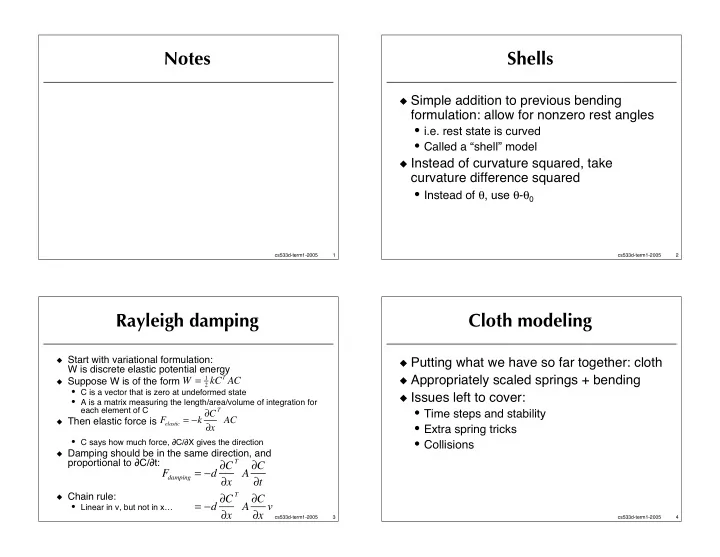

Notes Shells � Simple addition to previous bending formulation: allow for nonzero rest angles • i.e. rest state is curved • Called a “shell” model � Instead of curvature squared, take curvature difference squared • Instead of � , use � - � 0 cs533d-term1-2005 1 cs533d-term1-2005 2 Rayleigh damping Cloth modeling � Start with variational formulation: � Putting what we have so far together: cloth W is discrete elastic potential energy 2 kC T AC W = 1 � Appropriately scaled springs + bending � Suppose W is of the form • C is a vector that is zero at undeformed state � Issues left to cover: • A is a matrix measuring the length/area/volume of integration for elastic = � k � C • Time steps and stability each element of C T F AC � Then elastic force is � x • Extra spring tricks • C says how much force, � C/ � X gives the direction • Collisions � Damping should be in the same direction, and damping = � d � C A � C proportional to � C/ � t: T F � x � t = � d � C A � C T � Chain rule: � x v • Linear in v, but not in x… � x cs533d-term1-2005 3 cs533d-term1-2005 4
Spring timesteps Bending timesteps � For a fully explicit method: � Back of the envelope from discrete energy: • Elastic time step limit is � a 2 � 2 � � � L 2 � x � 1 m B e � x 2 = O � � � � L 2 L 2 L 2 A � � � � mL 2 � = O 1 � t � O � � � � � � � 1 � EA � n � t = O � � � � n 2 • Damping time step limit is � � � t � O mL 2 � � 1 � Or from 1D bending problem � = O � � � � � � � n 2 DA • [practice variational derivatives] • What does this say about scalability? cs533d-term1-2005 5 cs533d-term1-2005 6 Fourth order problems Implicit/Explicit Methods � Linearize and simplify drastically, look for steady-state � Implicit bending is painful solution (F=0): spline equations � In graphics, usually unnecessary • Essentially 4th derivatives are zero • Dominant forces on the grid resolution we use tend to be the 2nd • Solutions are (bi-)cubics order terms: stretching etc. � Model (nonsteady) problem: x tt =-x pppp � But nice to go implicit to avoid time step restriction for ( ) = e ( ) • Assume solution � 1 k p � ct stretching terms x p , t � No problem: treat some terms (bending) explicitly, others Wave of spatial frequency k, moving at speed c (stretching) implicitly • [solve for wave parameters] • v n+1 =v n + � t/m(F 1 (x n ,v n )+F 2 (x n+1 ,v n+1 )) • Dispersion relation: small waves move really fast • All bending is in F 1 , half the elastic stretch in F 1 , half the elastic • CFL limit (and stability): for fine grids, BAD stretch in F 2 , all the damping in F 2 • Thankfully, we rarely get that fine cs533d-term1-2005 7 cs533d-term1-2005 8
Hacking in strain limits Extra effects with springs � Especially useful for cloth: � (Brittle) fracture • Biphasic nature: won � t easily extend past a certain • When a spring is stretched too far, break it point • Issue with loose ends… � Sweep through elements (e.g. springs) • If strain is beyond given limit, apply force to return it to � Plasticity closest limit • Whenever a spring is stretched too far, • Also damp out strain rate to zero change the rest length part of the way � No stability limit for fairly stiff behaviour • But mesh-independence is an issue… � More on this late � See X. Provot, “Deformation constraints in a mass- spring model to describe rigid cloth behavior”, Graphics Interface '95 cs533d-term1-2005 9 cs533d-term1-2005 10
Recommend
More recommend